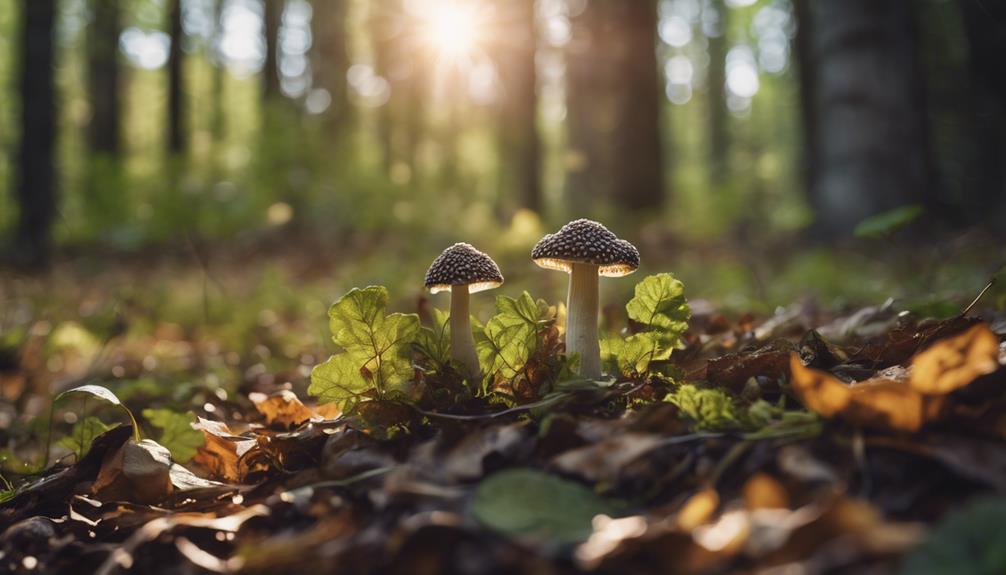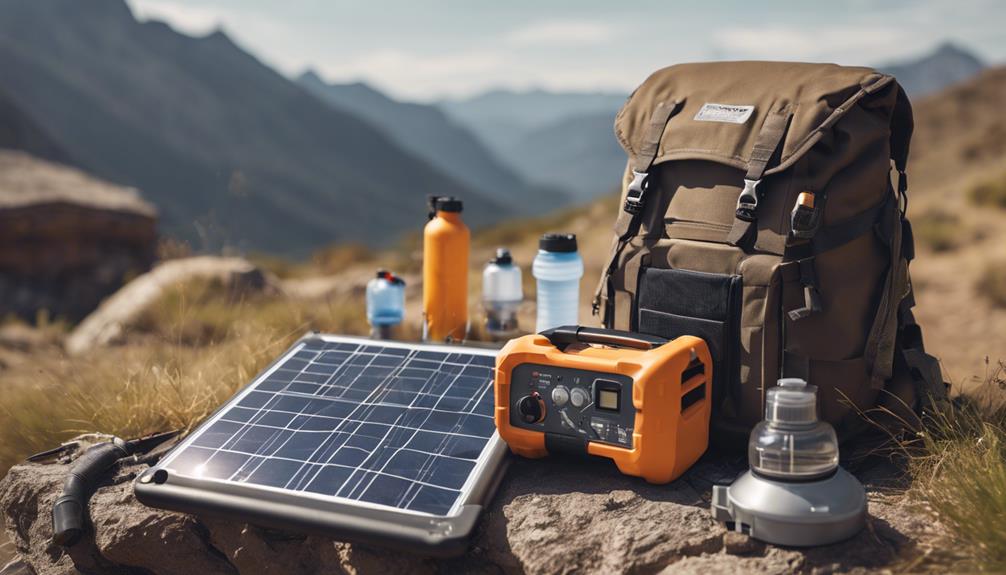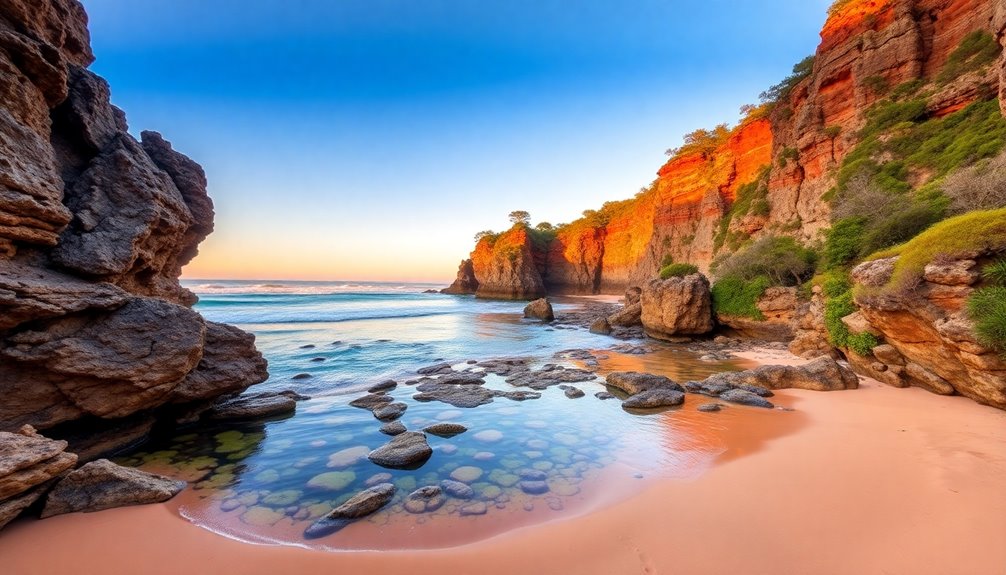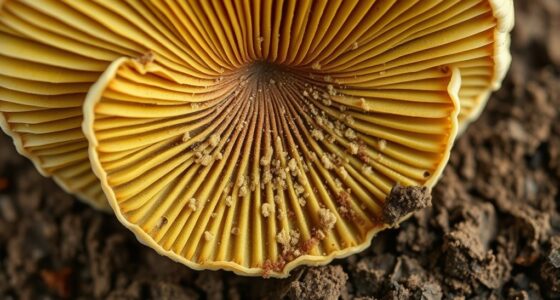In Michigan, you can forage for a wide variety of wild edibles, from fruits like raspberries, blueberries, and apples to greens like dandelion, lamb's quarters, and purslane. Mushrooms like morels, chanterelles, and oyster mushrooms can be found, but beware of poisonous lookalikes. Edible flowers and herbs like violet, wild mint, and bergamot add flavor and nutrition to your meals. With proper identification and safety guidelines in mind, you can enjoy the bounty of Michigan's woods, fields, and waterways. As you explore the Great Lakes State, you'll discover even more hidden gems waiting to be uncovered.
Key Takeaways
- Michigan's woodlands offer a variety of wild edibles, including blackberries, raspberries, blueberries, and apple trees.
- Seasonal foraging highlights include fiddleheads in spring, wild berries in summer, and high bush cranberries in autumn.
- Mushrooms like morels, chanterelles, and oyster mushrooms can be found in Michigan, but proper identification is crucial to avoid poisonous lookalikes.
- Wild greens like dandelion, lamb's quarters, and purslane provide a nutritious addition to meals, with diverse flavors and textures.
- Michigan is home to edible flowers and herbs, such as violet, wild mint, and wild bergamot, ideal for adding flavors to salads, teas, and desserts.
Foraging in Michigan's Woodlands
As you venture into Michigan's woodlands, you'll likely stumble upon a medley of wild edibles, including brambles like blackberries, which thrive at the forest's edge.
Wild berries are abundant in Michigan's forests, and you might also come across other varieties like raspberries and blueberries.
As you explore the woodland's edge, keep an eye out for wild onions, which resemble garlic and onion, and grow in abundance.
You might also spot beach peas with their beautiful flowers, often surrounded by wild grapes. Occasionally, you'll stumble upon apple trees in certain forested regions.
Amidst the woods, you'll find an array of wildflowers, including goldenrod, wild carrots, and milkweed.
These wild edibles can add flavor and nutrition to your meals, but remember to always identify them correctly to safeguard your safety. Take your time, and don't be afraid to dig in and discover the natural bounty that Michigan's woodlands have to offer.
Wild Edibles in Season

When you delve into Michigan's wild edibles, it's crucial to know what's in season.
Throughout the year, different seasons bring unique opportunities to forage for various plants and game.
From spring's fiddleheads to summer's berries, and fall's cranberries, each season offers a diverse array of wild edibles waiting to be discovered.
Spring Delicacies Abound
In Michigan's forests and waterways, you'll find a treasure trove of spring delicacies waiting to be foraged, from fiddleheads to walleye.
As you venture out, keep an eye out for wild onions, also known as ramps or leeks, which grow abundantly in Michigan's forests. These pungent, onion-garlic flavored treats are a sought-after springtime find.
You might also stumble upon morel mushrooms, recognizable by their distinctive honeycomb appearance. These highly coveted fungi are a flavorful addition to any spring foraging haul.
If you're near a river or lake, try your hand at catching trout or walleye, popular freshwater fish that thrive in Michigan's waters during the spring season.
And don't forget to forage for fiddleheads, the young, coiled fronds of ferns that are a prized spring delicacy.
With a little know-how and patience, you can fill your basket with these delicious wild edibles and savor the flavors of Michigan's spring season.
Summer Bounty Begins
You'll find a new wave of wild edibles ripe for the picking as Michigan's summer season unfolds. Foraging for wild berries becomes a treat in the Great Lakes State, with blueberries, raspberries, and blackberries ripe for the picking.
Wild blueberry shrubs, with their small, pointed leaves and pinkish-white flowers, produce nutrient-rich berries perfect for snacking or baking. Brambles like raspberries and blackberries grow in clusters of hollow-capped, compound berries, ideal for jams, jellies, and pies.
Elderberries, with their dark purple, juicy fruits on fast-growing plants with toothed leaves, are perfect for cooking into syrups and baked goods. And don't forget Juneberries, also known as serviceberries, with their purplish blueberry-like fruits found on shrubby trees, perfect for fresh consumption or use in various dishes.
As you explore Michigan's wilderness, remember to forage responsibly and sustainably, respecting the environment and other foragers. Happy foraging!
Autumn Harvest Highlights
Autumn's cooler temperatures and changing foliage signal the arrival of a new crop of wild edibles in Michigan, ripe for the picking. As you venture out, you'll discover a diverse array of flavors and ingredients to explore and enjoy.
| Wild Edible | Flavor Profile | Uses |
|---|---|---|
| High Bush Cranberries | Tart, slightly sweet | Jams, jellies, sauces |
| Sheep Sorrel | Tangy, slightly sour | Salads, soups, sauces |
| Wild Grains (e.g., Wild Rice, Amaranth) | Nutty, slightly sweet | Side dishes, salads, bread |
You can also stumble upon sumac berries, which add a tangy, fruity flavor to dishes. Take advantage of autumn's bounty to stock up on these nutritious additions to your meals. Whether you're a seasoned forager or just starting out, Michigan's autumn harvest has something to offer. So, grab your basket and get foraging!
Berries and Fruits of Summer

As you venture into Michigan's summer landscape, you'll discover a treasure trove of wild berries and fruits ripe for the picking.
From the sweet, antioxidant-rich blueberries that blanket the ground to the tart, juicy raspberries that ripen early, summer's bounty is a forager's paradise.
As you explore the Points, you'll uncover a wealth of flavors and textures waiting to be savored.
Wild Blueberries Abound
While wandering through Michigan's summer landscapes, you're likely to stumble upon wild blueberry shrubs, identifiable by their small, pointed leaves and clusters of pinkish-white flowers.
These wild foods are a treasure trove of nutrition, rich in vitamin C and antioxidants. As you forage for these wild blueberries, keep an eye out for the telltale signs of ripeness – a blue-to-purple color and a distinctive five-pointed crown on their undersides.
Mid-to-late summer is the perfect time to find them. Enjoy your bounty fresh, dried, or used in preserves and baked goods. Michigan's wild blueberries offer a flavorful and nutrient-rich addition to dishes like pies, muffins, and smoothies.
With their versatility and nutritional benefits, it's no wonder they're a popular choice among foragers. So, get out there and start searching for these delicious and healthy wild foods! Foraging wild foods in your backyard can be an enjoyable and rewarding activity, offering a unique connection to nature. Not only does it provide fresh, organic ingredients, but it also allows you to explore the natural richness right outside your door. Just be sure to research properly and identify your finds accurately to ensure you’re harvesting safe, edible plants.
Raspberries Ripen Early
Summer's warmth coaxes raspberries into ripeness, making them one of the first berries to be ready for foraging in Michigan's fields and forests. As you venture out, keep an eye out for thickets of woody canes with thorns, toothed leaves, and white flowers – a telltale sign of raspberries.
| Characteristics | Description |
|---|---|
| Appearance | Hollow-capped, compound berries in clusters |
| Growth Pattern | Thickets with woody canes, thorns, and toothed leaves |
| Uses | Make smoothies, jams, jellies, pies, and tea-like infusions from leaves |
When foraging, remember that raspberries often grow on the forest floor or along woodland edges. Their distinct growth pattern makes them easily identifiable. You can enjoy these sweet treats in a variety of ways, from snacking fresh to baking into pies. Take advantage of summer's bounty and get foraging!
Mushrooms of the Great Lakes

Head into Michigan's forests in the spring, and you'll be on the hunt for prized morel mushrooms, a treasured find among the state's many wild edibles.
As you venture into Michigan State's lush woods, you'll discover that morels aren't the only delicacy waiting to be unearthed. Chanterelles, hen of the woods, and oyster mushrooms are just a few of the edible species that call Michigan home.
However, it's important to exercise caution when foraging for wild mushrooms. Be aware of poisonous lookalikes like the false morel, and never consume a mushroom without proper identification.
To guarantee a safe and successful foraging experience, consider joining mushroom identification workshops or foraging groups. These resources will enhance your knowledge and provide valuable guidance as you hunt for wild mushrooms.
With the right skills and knowledge, you'll be well on your way to uncovering the hidden gems of Michigan's forests. So, grab your basket and get ready to uncover the flavors of the Great Lakes State!
Foraging for Wild Greens

As you've mastered the art of mushroom foraging, turn your attention to the lush undergrowth, where a variety of wild greens await your discovery. Michigan's wild greens, such as dandelion, lamb's quarters, and purslane, offer a nutritional powerhouse and unique flavors to elevate your meals.
These wild edibles are rich in vitamins, minerals, and antioxidants, making them a healthy addition to your diet.
When foraging for wild greens, remember to always obtain landowner permission before venturing onto private property. Once you've got the green light, start by identifying the greens.
Dandelion leaves are recognizable by their toothed edges and bitter taste, making them perfect for salads or cooked dishes. Lamb's quarters have a mild spinach-like flavor and can be sautéed, added to soups, or used as a salad green. Purslane, a succulent plant with a lemony taste, is high in omega-3 fatty acids and can be enjoyed fresh in salads or cooked in various dishes.
Edible Flowers and Herbs

You'll find an array of edible flowers and herbs in Michigan's wild, from vibrant violets to fragrant wild mint, waiting to be discovered and incorporated into your culinary creations. These wild edibles add unique flavors and aromas to dishes, salads, and beverages, elevating the taste and presentation of home-cooked meals.
| Edible Flower/Herb | Description | Culinary Use |
|---|---|---|
| Violet | Delicate, purple flowers with a sweet flavor | Salads, desserts, and beverages |
| Wild Mint | Fragrant, green leaves with a cooling flavor | Teas, cocktails, and desserts |
| Wild Bergamot | Yellow, orange, or purple flowers with a citrusy flavor | Salads, sauces, and marinades |
When foraging for edible flowers and herbs, it's essential to properly identify them to ensure safe consumption. Be aware of invasive species, which can outcompete native plants and harm ecosystems. By doing so, you'll not only enjoy the flavors of Michigan's wild but also contribute to the preservation of the state's natural beauty.
Rules and Safety Guidelines

Before you start foraging, make certain you're aware of the rules and regulations in Michigan to avoid fines, penalties, or even harming the environment. Make certain you understand what's allowed and what's not on public and private lands.
Foraging on public lands is allowed for certain items, but there are restrictions. You can collect mushrooms, nuts, berries, and tree fruits, but whole plants or maple sap can only be harvested on private lands. Be aware that harvesting isn't permitted if plants are destroyed, and protected species like wild ginseng can't be collected from public lands.
Here are some key guidelines to keep in mind:
- Unauthorized harvesting from private property isn't allowed without landowner permission.
- Possession of plants or animals on the Invasive Species Prohibited and Restricted List is prohibited.
- Only harvest for personal use, not for resale, and only from state lands.
Remember to properly identify wild foods to avoid health risks, and always follow the rules to ensure sustainable and responsible foraging practices.
Frequently Asked Questions
What Plants Are Edible in the Great Lakes?
You'll find edible brambles like raspberries and blackberries, wild onions, and beach peas in the Great Lakes region. Look for alliums with spiky stems and white or purple flowers, and don't forget to identify mushrooms safely!
How Do You Forage Wild Edibles?
You start foraging wild edibles by studying plants' unique characteristics, using Michigan-specific resources, and joining guided tours or classes to gain hands-on experience and expert knowledge.
Are Wild Berries Edible in Michigan?
You're wondering if wild berries in Michigan are edible? Absolutely! You can forage for delicious and nutritious berries like blueberries, raspberries, and elderberries, rich in antioxidants and vitamins, and enjoy them fresh, dried, or in tasty recipes.
How Do You Identify Wild Edibles?
'Are you prepared to discover the secrets of the wild? When identifying wild edibles, you'll need to examine key features like leaf shape, flower color, and growth patterns to make sure you're picking the right plants, not poisonous look-alikes.'
Conclusion
As you forage through Michigan's woodlands, remember that every wild edible holds a secret. Like a hidden treasure, they await discovery.
Just as a single acorn can grow into a mighty oak, one foraging trip can spark a lifelong passion. So, venture out, and let the Great Lakes State's wild bounty surprise you.
Who knows, you might just stumble upon a hidden gem, just like the rare chanterelle mushroom that grows only in Michigan's northern woods.
Happy foraging!










